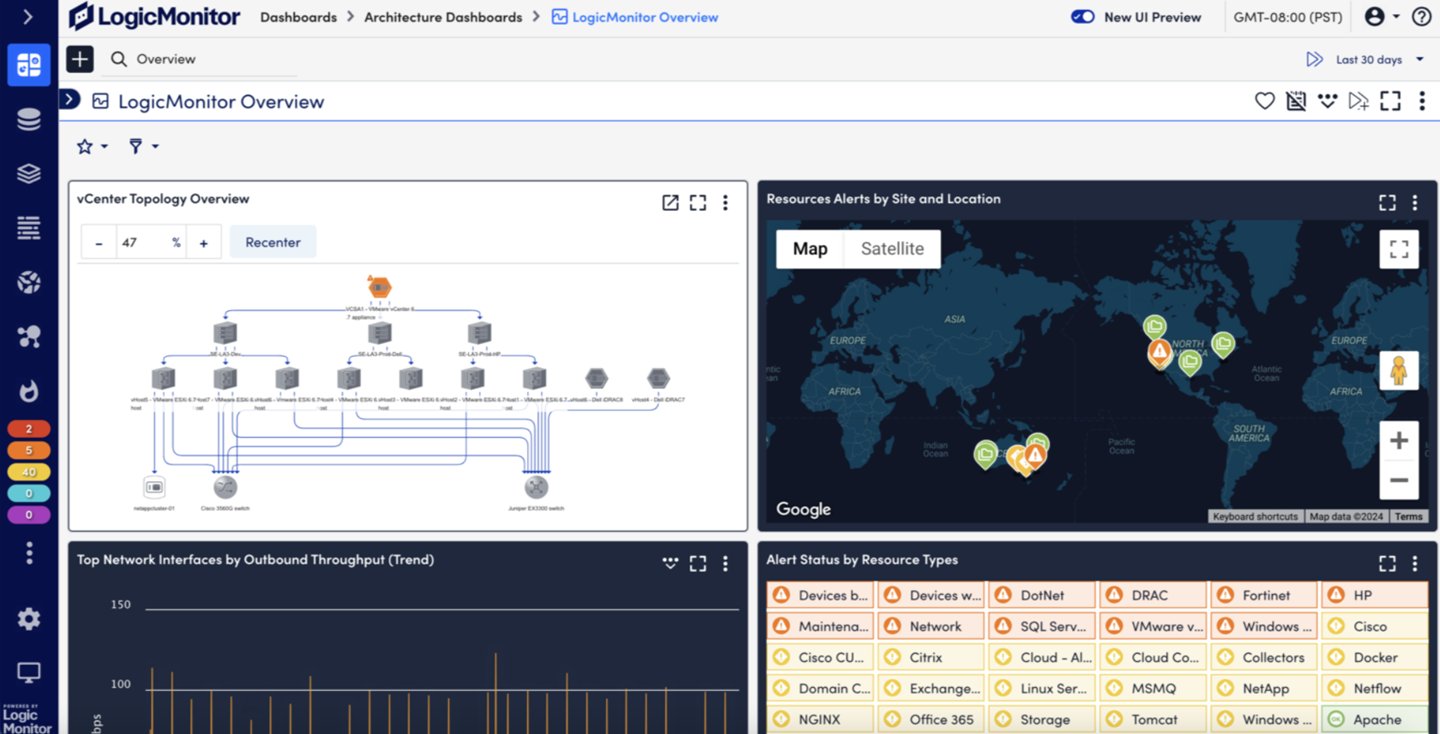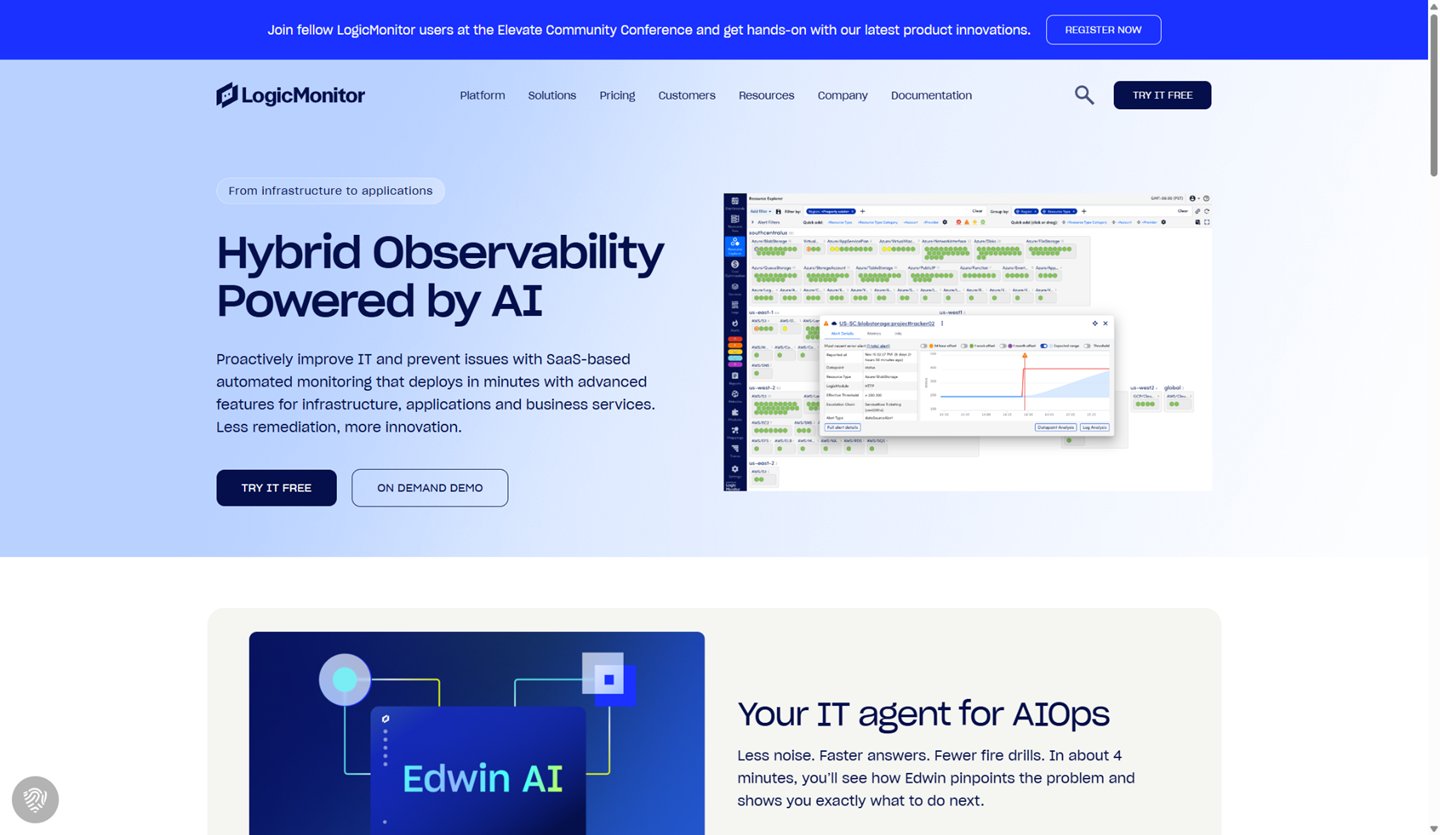TechRadar Verdict
LogicMonitor is Techradar’s best network monitoring tool for 2025, thanks to powerful AI automation and more than 3000 integrations. While pricier than many rivals, its ability to automate complex IT workflows with full visibility makes it a no-brainer for IT teams who want reliability and innovation.
Pros
- +
Real-time AI alerts
- +
Deep device integrations
- +
Automated topology mapping
Cons
- -
Steep learning curve
- -
High starting price
- -
A few UI inconsistencies
Why you can trust TechRadar
If you’re searching for a network monitoring platform that can handle hybrid, cloud, and on-premises IT environments without breaking a sweat, LogicMonitor deserves some serious consideration. We’ve spent weeks comparing the best network monitoring tools of 2025 and LogicMonitor consistently leads the pack for the enterprise crowd.
At TechRadar Pro, our reviewers dive deep into every major IT platform, evaluating features, integrations, and real-world usability. We look for the things that IT teams actually need, beyond the elevator pitch and the blown-up promises.
For 2025, LogicMonitor is our pick among network monitoring tools. Its AI-powered suite can automate many day-to-day IT workflows, reducing manual effort and helping teams focus on what matters. If your organization values proactive issue detection, automated insights, and seamless scalability, LogicMonitor is well worth a closer look.
LogicMonitor: Features
LogicMonitor is loaded with features for modern IT teams managing complex hybrid environments. It’s best suited for medium-to-large organizations that need precise visibility, automation, and scalability. Execution is generally excellent, with AI-driven insights and 3000+ integrations being a major upside.
But we’d still like to see more intuitive onboarding for new users and some advanced analytics that competitors like Datadog already offer. Given its features, the price feels justified, but only if you plan to use all the features.
Infrastructure monitoring
LogicMonitor tracks the health and performance of all your devices, like servers, storage, VMs, and more, across both on-premise and cloud environments. It automatically discovers devices and provides detailed metrics for each one.
Sign up to the TechRadar Pro newsletter to get all the top news, opinion, features and guidance your business needs to succeed!
Network monitoring
Their platform continuously monitors network traffic, device status, and bandwidth usage. It auto-discovers devices, maps network topology, and uses intelligent alerting to notify you of anomalies in real time.
Log analysis
LogicMonitor centralizes log data from across your infrastructure, correlating it with metrics to give you context for troubleshooting. Flexible retention options let you choose how long to keep your data.
Synthetic monitoring
You can simulate user interactions and monitor website uptime and performance, helping ensure a smooth end-user experience.
AI and automation
LogicMonitor’s AI features automate anomaly detection, event correlation, and alert prioritization. This reduces alert fatigue and helps teams focus on what matters most.
Dashboards and reporting
Customizable dashboards and automated reports make it easy to visualize trends, share insights, and keep stakeholders informed.
Integrations
With over 3,000 integrations as of right now, LogicMonitor works with nearly every major device and cloud service, so you can monitor your entire stack from one place.

LogicMonitor: Ease of use
LogicMonitor’s interface is modern and intuitive, especially after its recent UI overhaul. The new design focuses on usability, with resource-level dashboards, streamlined navigation, and a consistent look across the platform. The resource explorer and enhanced topology mapping make it easier to manage complex environments and troubleshoot issues quickly.
However, there’s still a learning curve, especially for users new to network monitoring. Some advanced features and customizations require time to master, and a few UI elements can feel clunky or buried under menus. While onboarding guidance has improved, junior engineers may still need extra training to get comfortable. On the plus side, LogicMonitor offers live training webinars and plenty of documentation to help teams ramp up faster.
LogicMonitor: Pricing
Plan | Starting price (paid annually) | What’s included |
|---|---|---|
Infrastructure Monitoring | $22/resource/month | Standard events and metrics, 900+ integrations, servers, VMs, SD-WAN, storage, network devices, cloud |
Cloud IaaS Monitoring | $22/resource/month | AWS EC2, Azure VM, cloud infrastructure, standard integrations |
Wireless Access Points Monitoring | $4/resource/month | Juniper Mist, Cisco Meraki devices, wireless network monitoring |
Cloud PaaS & Container Monitoring | $3/resource/month | AWS, Azure, GCP, Kubernetes, MongoDB Atlas, Docker |
Log Intelligence |
$2.50–$7/GB/month
| Log analysis, 7-day to 1-year retention |
Edwin AI | Contact sales | AI automation, advanced analytics |
*All prices USD/month, billed annually. “Per resource” means each monitored device or instance.
LogicMonitor’s pricing is resource-based, which can add up quickly for large environments. The entry-level plans cover most standard monitoring needs, but advanced features (like AI automation or extended log retention) may require add-ons or higher-tier plans.
Compared to competitors, LogicMonitor is on the expensive side, but the depth and breadth of features help justify the investment for organizations that need them.
LogicMonitor: Customer support
LogicMonitor is known for responsive, knowledgeable customer support. Most users consistently praise the team for proactive communication, regular check-ins, and genuine advice. Support is available via live chat, email, and phone, and there are live training webinars every other week for ongoing education.
Support packages come in tiers: Standard support is included for all customers, while Premier and FedRAMP plans add proactive monitoring, health checks, and remediation assistance. Premier customers get regular account reviews and early alerts about potential issues, plus priority access to senior engineers. The main caveat is that some advanced support features are only available at higher tiers, so small teams may not get the same level of hands-on help.
LogicMonitor: The competition
LogicMonitor sits at the high end of the network monitoring market, best suited for organizations that need deep, automated insights across hybrid and cloud environments. It’s a top pick for enterprises, managed service providers, and fast-growing IT teams who want to future-proof their monitoring stack.
Main competitors include Datadog, Dynatrace, and New Relic. Datadog offers similar AI-powered monitoring and a broader analytics suite, but at a comparable or higher price. Dynatrace is praised for ease of use and tight cloud integrations, making it a good fit for teams focused on cloud-native infrastructure. New Relic stands out for its flexible pricing and developer-friendly tools, but may lack some of LogicMonitor’s enterprise features. For smaller organizations or those with simpler needs, these alternatives might offer a better balance of features and cost.
LogicMonitor: Final verdict
LogicMonitor is a powerhouse for network monitoring, offering unrivaled visibility, automation, and AI-driven insights. Its real-time alerting, deep integrations, and automated topology mapping make it an invaluable tool for IT teams managing complex environments. While the learning curve and premium pricing may give some pause, the overall value is hard to beat if you need best-in-class monitoring.
For 2025, LogicMonitor is our pick for the best network monitoring tool, especially for organizations ready to invest more for reliability and consistency. If you want to automate IT workflows with full transparency, LogicMonitor is well worth the investment.
FAQs
Is LogicMonitor suitable for small businesses?
LogicMonitor is designed for mid-sized to large organizations. Its pricing and feature set may be overkill for small businesses, but it can be scaled down if you only need to monitor a handful of resources.
What kinds of devices can LogicMonitor monitor?
LogicMonitor supports a wide range of devices, including routers, switches, firewalls, servers, wireless access points, storage systems, and cloud resources. It integrates with over 3,000 vendors and protocols.
Does LogicMonitor offer a free trial?
Yes, LogicMonitor offers a free trial so you can test the platform before committing. This lets you explore features and see how it fits your environment.
How does LogicMonitor’s AI help IT teams?
LogicMonitor’s AI automates anomaly detection, alert prioritization, and event correlation. This reduces manual effort, cuts down on alert noise, and helps teams focus on critical issues.
What support options are available?
Standard support is included, with live chat, email, and webinars. Premier and FedRAMP customers get proactive monitoring, health checks, and priority access to senior engineers.

Ritoban Mukherjee is a tech and innovations journalist from West Bengal, India. These days, most of his work revolves around B2B software, such as AI website builders, VoIP platforms, and CRMs, among other things. He has also been published on Tom's Guide, Creative Bloq, IT Pro, Gizmodo, Quartz, and Mental Floss.
You must confirm your public display name before commenting
Please logout and then login again, you will then be prompted to enter your display name.
